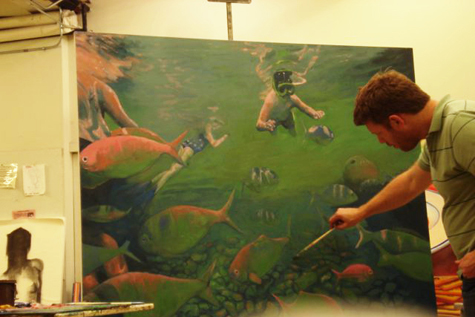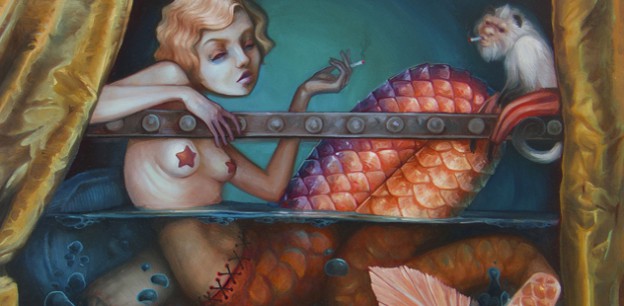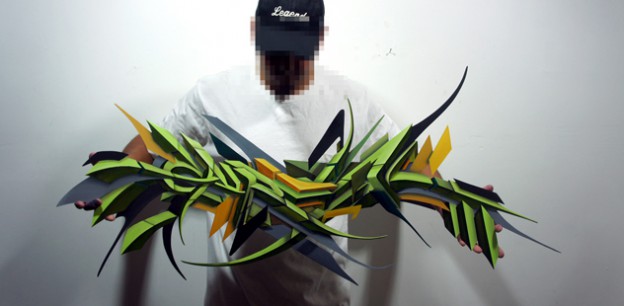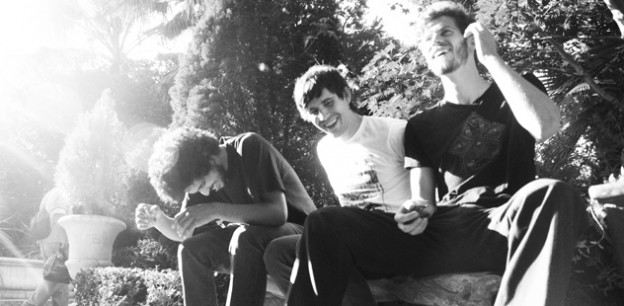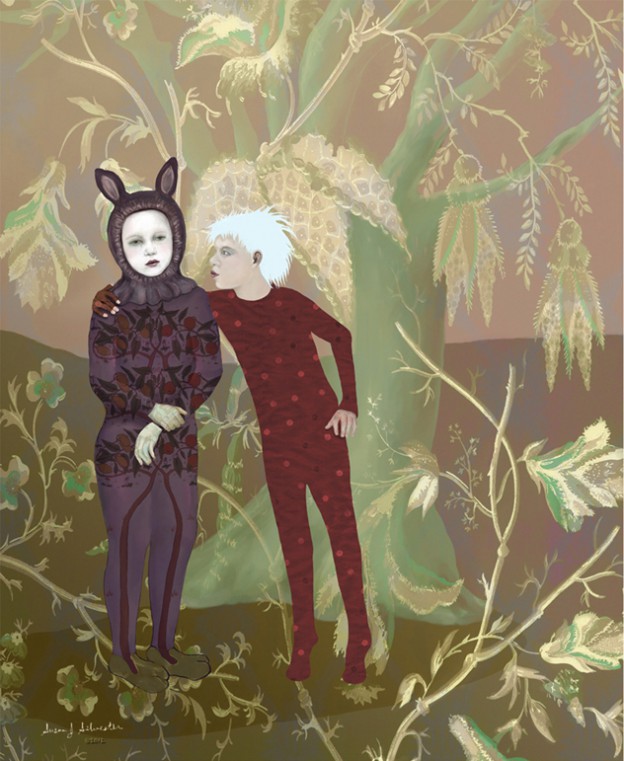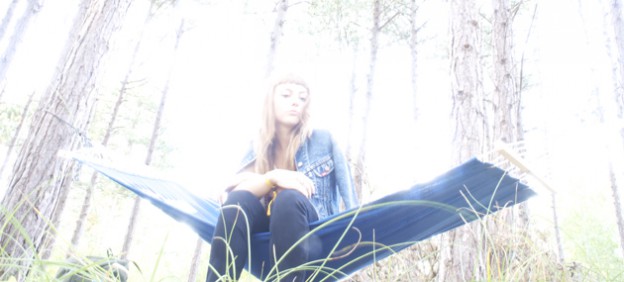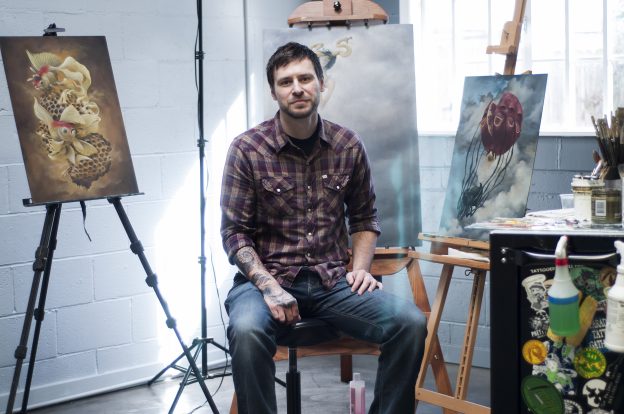Society through the Eyes of Jacqueline Gallagher
Jacqueline Gallagher wants to be taken seriously as an artist—just don’t take her art too seriously.
Gallagher sees the gorgeous and the grotesque in humanity, finds the comic relief and intricately recreates it in her oil paintings and drawings.
The centerpiece for her upcoming Sacramento solo show, Satirical Saturation, is a Fiji “Octomaid”—half a woman stitched to half a floppy, twisting tentacled creature.
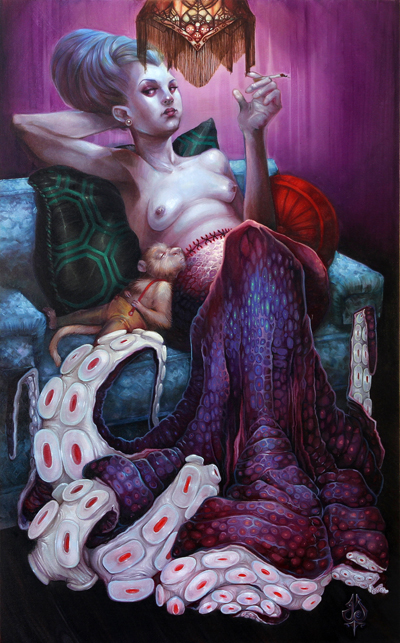
{Manganese Violet}
The segments’ details—human and octopus—sag and ooze realistically in purple and fleshy pink and a sleepy monkey completes the image.
“There’s a sexual element to it, too, that brings up the idea of fetishism and objectivity,” Gallagher says. “I post my work on various forums online for critique, and my favorite comment so far was on this piece. It was, ‘Pretty cool, I wish she was hotter but whatever.’”
Mythological characters influence her latest collection, specifically satyrs, Medusa, other gorgons and classic demons.
“The way I see it, people really haven’t changed much,” she says. “We’re still just as vain, overindulgent, self-interested, and decadent, and these characters, with their protruding horns and snakes, represent those very human traits.”
The show works off some of her previous paintings and exhibits, which have included candy-colored mermaids smoking with monkeys and deathly women covered in bugs but growing unicorn horns.
Earlier influences spring from her childhood in Hawaii, where Gallagher still resides. The islands still have a place in her work, which often portrays oceanic or jungle creatures. Or her house cats. What tourists might consider inspiration, however, Gallagher considered somewhat of a chokehold.
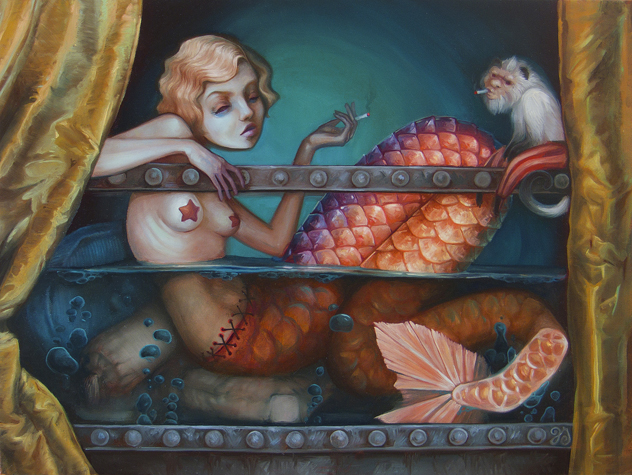
{Goldie Between Viewings}
“When I first started painting, everything was very Hawaii-oriented—ocean landscapes and flowers and all that and that’s what I started out painting because that’s all I saw,” Gallagher says. “In college, I started looking at work from out of the islands and got more inspired. I don’t know, it was actually kind of limiting growing up in Hawaii.”
Gallagher also worked in the commercial art business, and the kinds of customers she encountered sometimes ended up as inspiration for the flawed human condition represented in her work.
Japanese art, cartoons and anime also influenced her style as a kid, leading her to experiment exaggeration with bright colors and shapes.
“What’s funny is I try to make the paintings a little dark, since I’m really interested in opposition and mixing something really pretty with something really grotesque and slimy, but sometimes people don’t always get the humor,” Gallagher says. “I’ve seen some horror art and this is not even close.”
It’s been five years since Gallagher launched a website and started touring nationally with her work, exhibiting in San Francisco, Sacramento and Brooklyn galleries specializing in pop culture, macabre and surrealism.
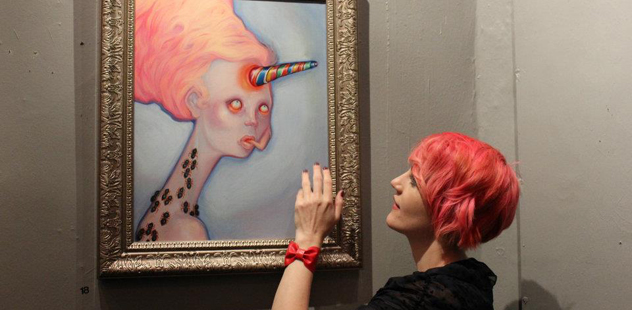
Over that time period, the 30-year-old has gained a strong fan base, which she credits to social media and Creep Machine Magazine, an online publication currently being reworked.
“I talked to this guy online, Joshua G., from Creep Machine, and he was really encouraging and he had me participate in a San Francisco show and got my website started too,” she says. “He just looked for art online and found me. That helped me jump off and get me on your coast there. It’s all social media that’s made it possible, really.”
Joshua had been scouring sites likes Deviantart.com when he stumbled upon Gallagher’s work and wanted to share and provide an interview for Creep Machine.
“The first painting I saw of Jackie’s was A Well Trimmed Bush,” he says, referencing a painting of a smoking woman in a lace dress with ghostly eyes and an equally ghostly-eyed cat.
“I loved the classic feel the painting had, the pose, and the attention to detail as seen in the drapery, lace, and skin tones,” Joshua says. “It’s a beautiful painting, but there is also a vibe of creepiness to it that draws you in, makes you want to see what else this artist has created.”
The web designer/art supporter says artists face economic challenges today that have made it harder to live off their work, and he feels it’s partly because the public consumes art differently.
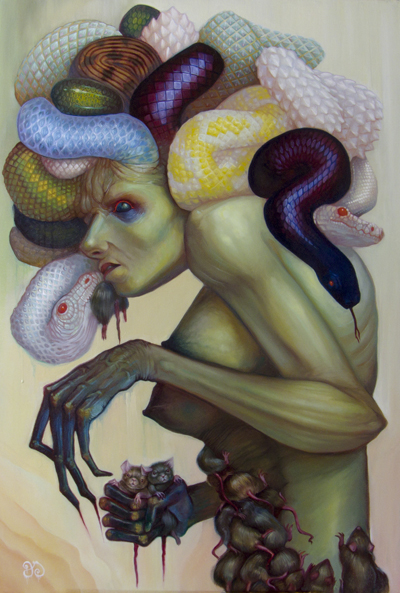
{Classic Medusa}
“So much art is consumed digitally now, and I think people need to remember that most of the time the work of art they are looking at, and sharing on social media, exists and might even be for sale,” he says. “Owning art is seen as a luxury to many people, but it is possible and can nurture and support the artists when people do buy the work. With that said, I think that darker forms of art are gaining in popularity. There are of course darker works that tend to be too much for people to buy and hang in their houses, but Jackie has done a great job of creating ‘dark’ works of art, that are also enticing.”
Joshua notes artists like Caravaggio and Francisco Goya (with his Disasters of War series), as well as Black Paintings from the 1800s as great examples of classical “dark art.” He says today’s movement takes more of a nod from pop culture trends.
“When you really dig deep you see that there is some amazing and beautiful works of art that are not created simply for the sake of being dark/shocking, but are telling stories, commenting on social and cultural issues, and in many ways helping the artists that create the imagery to deal with what they see around them,” he says.
Gallagher has successfully used social media and her website as storefronts for her artistic commentary, and currently lives off of her creations.
“It’s a really good time to be an artist right now because of social media,” she says. “It’s a good way for them to show off their work and a platform to meet other artists. It was good timing in my life, I guess.”
Gallagher says she doesn’t have much planned yet after her June 14, 2014, opening at Dragatomi in Sacramento.
She has started experimenting with other media and tools as well, and Oahu residents can often get lucky with a one-of-a-kind print at a monthly flea market the artist frequents with smaller, quickly created pieces. For the last few, she’s done everything from Wes Anderson characters to hot dog and hamburger monsters.
“I’ve been using watercolor and gouache a lot more lately and I’ve been kind of doing more graphic images with black ink and splashes of drippy color, so it’s less form and three-dimensionality,” she says.
She’d like to experiment with sculpture but continue to paint for a living.
“I like just having these solo shows sporadically but what I’d like to do is more nice quality prints and limited editions, so I’m trying to work on that.”
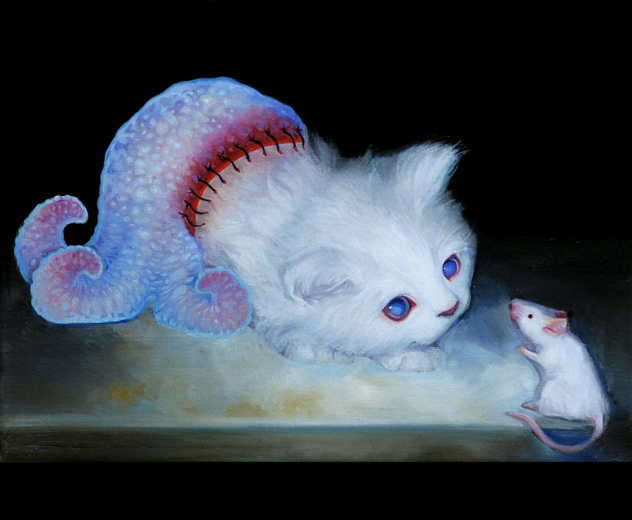
{Adolescent Octopussy}
Add Jacqueline Gallagher on Instagram, @Jackiepaintdead, to see her works in progress, her fun flea market prints and her cute kitties. Or, catch her starting June 14 through July 5, 2014 at Dragatomi, 2317 J Street, Sacramento.
Marsha Ambrosius prepares for album release
It’s not uncommon to pigeonhole ourselves into music genres, to skip a song or station because it doesn’t fit that perfectly curated Spotify playlist or it doesn’t sound familiar. However, some artists who often deserve a second listen transcend genres—their music becomes a mission and not just components of rhythm and beats, instruments and lyrics.
Singer/songwriter Marsha Ambrosius sees her work this way. She may not be on the local radio station loop, or popular with the young teens who now inflate musician stardom by buying perfume bottles and arena tickets, but she has a strong fan base that spans more than a decade.
In 2000, she topped charts and broke stereotypes, hailing from England as part of the female duo Floetry with Natalie Stewart. Even then, her lyrics did not shy away from sensuality and straight talk. After the duo split in 2005, several artists noticed Ambrosius’ songwriting skills.
She quickly built a name for herself as a songwriter and producer, penning “Butterflies” for Michael Jackson and hits for artists such as Alicia Keys, Justin Timberlake, Jamie Foxx and Nas, and received the BMI Songwriter of the Year Award.
The song “Far Away” from her debut solo album, Late Nights and Early Mornings, which got her a Grammy nomination and a 2011 Record of the Year Soul Train Award, addresses suicide, drugs, bullying and being gay and black.
“This is my free therapy—let this be the escape,” Ambrosius says on an afternoon before a Minneapolis show. “Sing songs with your emotions. Don’t be afraid to run away.”
By ear, one of her songs might be beautifully dramatic and heartbreakingly convincing. Paired with its video, the song takes on another heavy layer of meaning and purpose.
For example, one of her new singles, “Without You”—a duet with R&B star Ne-Yo—epitomizes a painful breakup. Ambrosius’ mournful, deep pitch followed by clear, high cries attests to it. But, watch the video with images of a young girl and what imagination leads to be an abusive father, and the wrenched gut from the powerful song twists even more.
When writing “Without You,” Ambrosius says the lyrics came as just another moment in time.
“I have a platform to speak on issues and topics that people would run away from,” the 36-year-old says. “Through social media I am able to connect directly with my fans and they find solace in talking about these things. I’m just glad I’m one of those who can help.”
Ambrosius lives on her social media pages like she’s working a desk job, even though she is always touring. She is signed on constantly, responding to tweets and reposting, sending fans and friends emoti-hearts, and in the process collecting more fans.
“We get to have open dialogue, whether we’re talking about Scandal on Thursdays or Walking Dead on Mondays,” she says. “That velvet rope, social media kind of removes that.”
Growing up in Liverpool, England, Ambrosius didn’t have social media to find and connect to music, but she lived in an area swarming with musicians—famous and even infamous.
“We had a very blessed opportunity to appreciate music. I know we of course had The Beatles, but we also listened to everything from Earth, Wind and Fire, to Queen…Gilberto Gil, anything that was great, and I knew of it all because my parents were avid vinyl collectors so I got to play pretend DJ,” she says.
Ambrosius’ upcoming album, Friends and Lovers, is about the vulnerable barrier between the two titles. Ambrosius calls the album an autobiography of her past relationships.
“Friends and Lovers is to be listened to responsibly,” she has said. The difference between her first album and the new one, she adds, is only the amount of time that has elapsed.
“I’ve had more experience in life since Late Nights and Early Mornings, so this is the sequel of what already was,” she says. “I had already wanted an album that was completely cohesive from beginning to end, but sometimes you can only make a song 3 minutes and 50 seconds and there is so much more to say. Like, what happened with that relationship?”
Early reviews of recently released singles praise Ambrosius’ range, compare her to Alicia Keys and Prince, and suggest the singer will reach a higher level publicly than ever before.
Ambrosius doesn’t have a release date for the album, because her plan had been to present it as a live album.
“This belongs to the people,” she says. “When you see it live then you experience the type of person I am and the voice I am for the people.”
The live experience, she adds, will also reflect her songwriting.
“The show, it’s very candid, very forward, very sensual, very melodic,” she describes. “Buckle your seatbelt.”
Ambrosius will play Harlow’s April 25, 2014 and believes an album will be released once her tour ends in Las Vegas May 10. She often brings in guest appearances and local talent to her shows, and noted she is researching Sacramento-area music to see who will open for her show. Doors open at 9; tickets start at $40. UPDATE: This show is currently SOLD OUT! Check out Facebook.com/submergemag for ticket giveaway!

Award-winning food blogger Hank Shaw talks fowl in his latest cookbook
Hank Shaw is an inspiring food writer and instructor. By combining his experience as a cook, hunter and investigative reporter in his James Beard award-winning blog, “Hunter, Angler, Garden Cook,” Shaw is considered one of the preeminent voices in the country for living off what you can catch, forage, grow or shoot. His latest cookbook, Duck, Duck, Goose: Recipes and Techniques for Cooking Ducks and Geese, both Wild and Domesticated, covers everything from how to pluck a wild bird or purchase a domestic one, to how to render its fat or cure it as prosciutto.
With mantras like, “If it grows together it goes together,” and “Eating everything but the quack,” Shaw exhibits a very unique repertoire and self-reflective, almost romantic mission of bringing honest cooking to your loved ones, from wilderness to table.
He has even successfully converted his girlfriend and photographer counterpart Holly Heyser into a hunter and duck meat lover. The two spend their hunting seasons not far from their home just outside Sacramento.
Shaw’s first book, Hunt, Gather, Cook: Finding the Forgotten Feast, and his current one (for which he’s on tour), are intense versions of “Hunter, Angler, Gardener, Cook,” which he launched in 2007 and has made his career. His recipes are well-researched, broken down into simple steps with photos (mostly by Heyser), and interspersed with interesting commentary on trends, personal experiences and his own food evolution.
With hundreds of cookbooks published annually, Duck, Duck, Goose stood out from the competition with Shaw’s insistence on learning to cook a creature that has for years scared home cooks, but at the same time has been a main course across the globe for millennia.
“The core of why I wrote the book is for home cooks,” Shaw says one afternoon in Denver before a book event at Old Major, a sustainability-focused restaurant similar to Sacramento’s Mulvaney’s B&L.
Shaw’s goal with Duck, Duck, Goose is to teach home cooks as well as avid hunters the specialized skills necessary to cook the more adventuresome fowl, especially those who may need to shred their breast-only comfort zones to fully experience every possibility of a bird.

{Tea-Smoked Duck}
Shaw, 42, wasn’t always so obsessed with duck, though he was an easy convert after his first taste of wild mallard.
“I’ve been foraging and fishing since I could walk…but I didn’t do a lot of hunting until my 30s,” Shaw says. “I didn’t even meet a hunter until I was 24.”
Shaw worked in Minnesota as a reporter when a friend gave him his first mallards and pheasant to cook and eat. “I was amazed at how good they were,” he says.
Ultimately, that began his journey for good food.
“When you’re fishing or foraging you perceive nature in a different way,” Shaw says of what appealed to him when he decided to continue this lifestyle. “You’re hyper aware of the elements, the current and the water, or the wind.”
Hunting, he adds, “makes you feel more alive, but it’s not about pulling the trigger, it’s about the process.”
For Heyser, just experiencing this process with Shaw changed her life.
“The tipping point, what got me to start hunting, was ducks,” she says. “Hank had started hunting them obsessively, and two things happened: One, he would be gone all day on weekends, and I was getting lonely. And two, the ducks he brought home and cooked were insanely delicious, and if I wanted more of them in the house, I would need to get a gun and go out with him.
“Now I can’t imagine life without hunting; I am never happier than when I’m out in the field with a gun. Even if I don’t get anything, that sense of possibility—the realization that you might get lucky and bring home something for dinner—is completely addictive.”

{Confit Salad with Frisée}
Shaw mentions in Duck, Duck, Goose that his most memorable meal to date is still an obese gadwall shot by Heyser just in time for Christmas dinner. A gadwall, as noted in the book, is a small brown duck Shaw calls “the duck lover’s bird,” but only when it feasts on grain and rice. That’s another thing you’ll learn from him: what an animal eats; its age; and where it flies, walks or waddles all matter in that making of a perfect meal.
Heyser went from being timid about cooking what she killed to “breaking down birds, cleaning gizzards, braising legs and searing duck breasts pretty fearlessly,” she says.
All of these techniques are photographed to assist cooks in the kitchen. Shaw also offers videos and tips on his blog to accompany the thousands of recipes that range from homemade spaetzle to braised squirrel. Something for everyone.
The menu at Mulvaney’s, where Shaw will be cooking a sold-out feast for enthusiasts on the book tour on Dec. 2, is not yet public; but it will focus on the book’s recipes. Several high-profile chefs have also cooked from the book during the tour, and the crowds are growing.
“The typical crowd is 60 to 70 percent home cooks and 30 to 40 percent hunters, which is what I envisioned for this tour,” Shaw notes. “Two years ago when I toured with my first book, a crowd was about 30 people. Now it’s 75 to 100. We sold out at Mulvaney’s a month early. It’s kind of blown me away, especially going someplace you’ve never been like Lexington, Ky., and receiving a warm welcome.”
One of the highlights of the tour occurred in New York City, where chef Anita Lo of renowned Annisa Restaurant said she would prepare three dishes from Shaw’s book.
“I’m not embarrassed to say she cooked them better than I did,” he laughs.
While being on tour for two full months, Shaw’s hunting days have waned. He has been able to go out a day here and there, and has learned to savor those days much more than when he would go out three to four times a week, he says.
Heyser has kept busy keeping the freezers filled and working at the nonprofit California Waterfowl. Shaw hopes to continue his passion after some rest.
Another book is not yet in the works, but he updates his blog regularly with timely recipes and suggestions or thoughts on the latest hunting controversies. He even includes entertaining stories of his past that lend themselves well to elevating a meal from a quick family dinner to a memorable, customizable event. If you get the book, check out examples of this in recipes for rarities like duck fat hollandaise or duck bulgogi—an adaptation of his mother’s adaptation after she tried the authentic version at the home of a Korean War veteran in the ‘60s.
To catch Shaw in action, check out his cooking demonstration at the Sacramento Natural Foods Co-op December 17, 2013 or check his website honest-food.net for upcoming book tour events.
Though Artist Victor Malagon has Moved from the Streets to the Galleries, He Refuses to be Complacent
A love of graffiti ties together three artists sharing a show at the Sacramento State University Union Gallery this month. Their colorful, fluid stories once told on cement walls are now immortalized through three different aesthetics (though still sometimes on walls) and have been appreciated by a large audience for more than 10 years.
One of these artists is Victor A. Malagon, who went from can to oil paint and wall to cut wood, transforming his edgy sketches into sharp, quarter-inch-thick flat panels that trick the eye with their 3D illusions.
Malagon says the thin wood creates a sense of vulnerability that represents the artwork painted on the streets.
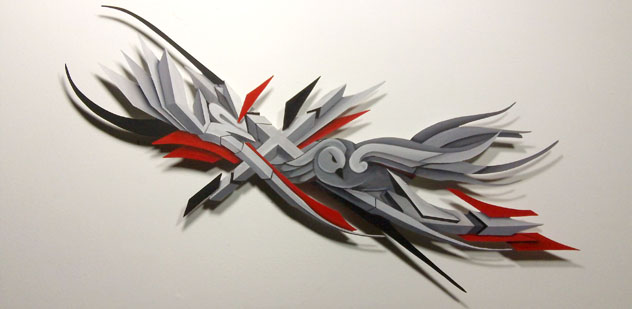
“Multiple hours, even days can be put in to create the artwork, but it can take seconds for it to be destroyed [dissed, covered up],” he says. “The same goes for my paintings; if not handled correctly, they can also easily be destroyed. At the same time, that kind of frailness and vulnerability is what makes them so unique and special.”
Malagon’s first exposure to graffiti occurred in high school.
“I had gone under the 7th Street bridge, a bridge that connects the south side of Modesto, Calif. to the downtown area and for the first time, I saw up close and personal the huge, colorful, wild style graffiti murals,” says Malagon, who moved to Modesto from Fremont, Calif. with his family when he was 13, and has since returned to settle there with his expecting wife. “That was it. At that time I had no idea who had painted those walls, how they had done it. I just knew that is what I wanted to do for the rest of my life.”
The successes of graffiti writers like Loomit and Delta, as well as the online global graffiti gallery Art Crimes, inspired Malagon to take his painting one step further, toward a career. However, he began work on his fine arts degree from a different perspective than his street art, with influence from the Bay Area Figurative movement of the ’50s and ’60s, and the Impasto style that uses thick brush strokes to provide texture on canvas.

“I spent a whole semester creating a body of work influenced by that style [but] at the end of the semester during the critiques, my work was basically slaughtered by the instructors,” Malagon says. “They said, ‘Why create something that has already been done?’ They were aware of my graffiti background, and they actually gave me permission to build a wall in the art department so I can paint and practice when I had free time. They said, ‘You are doing something unique with spray paint and that style… We think you should head in that direction.’”
Malagon felt disheartened and lost at first.
“I felt like they didn’t get it,” he recalls. “Graffiti to me belonged in the streets, on walls. I had no interest in painting graffiti on canvas. At that point, I felt like maybe art school was not my thing. I decided to focus that whole summer on my letter styles and painting more. I decided that I wanted to make my letter styles more unique in form. As I began to sketch and began to make my letters stretch and flow outside the page, I thought to myself, ‘how cool would this look as a shaped panel!’”
Malagon had studied the work of Frank Stella but never thought he could use Stella’s idea of the shaped canvas to his own work.
Starting in 2004, Malagon created his first pieces similar to the style he works in now. Those first pieces are different than his commissioned pieces today, with fewer razor-sharp edges and a more clunky design.
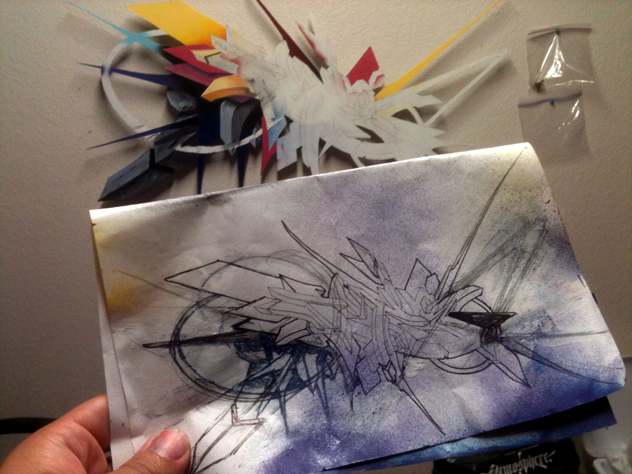
“I think that has to do with the use of tools, and learning how to use them and figuring out tricks on how to get that razor sharp and skinny without snapping or breaking the panel or cutting my fingers off,” Malagon says of the changes. “Also, as my style contentiously develops, the style changes. Unfortunately I have this attitude where nothing is ever good enough, so if I like something I did or just completed, a few hours later I start to dislike it and try to improve on it. I have been known to throw away and completely destroy paintings after spending over 80 hours on it if I feel it’s not good enough.”
Several artists from different fields and genres now recognize Malagon’s work and searched him out for commissioned pieces, including painter/designer/tattoo artist Chase Tafoya, DJ Reason, music producer Kenny Segal and Austin “Chumlee” Russell from the History Channel’s Pawn Stars.
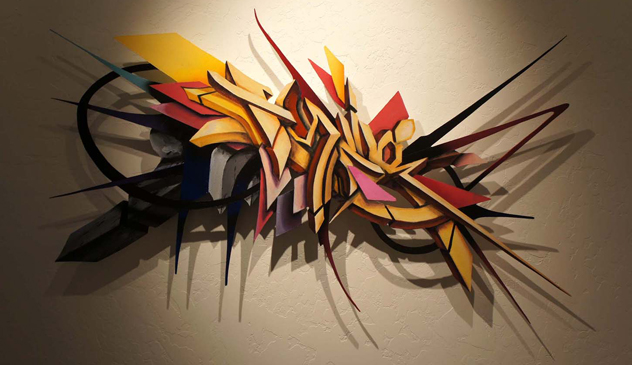
“I have been extremely lucky with the clients I get,” Malagon says. “I’m a fan of their work to begin with. I think Chase Tafoya was one of the first people who commissioned a piece. Music producer Kenny Segal!? Are you kidding? This guy makes beats for a lot of hip-hop artists I listen to. I remember when I dropped off the painting, he was telling me that Slug from Atmosphere was at his house last week! What? I’m a huge fan of Atmosphere.”
For Malagon, the best part about his commissioned pieces is the amount of freedom he receives. Clients might say they would prefer a certain color over another, but usually he gets “do your thing, dude.”
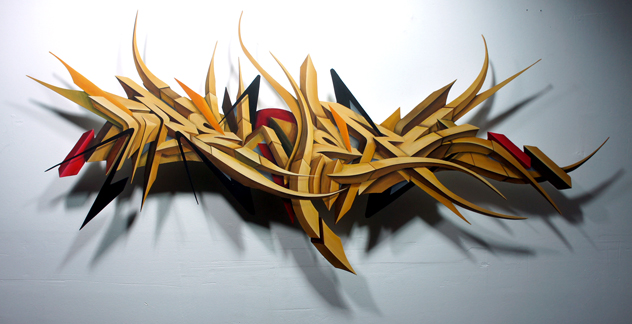
“I do try to research my clients and try to have a connection with them through my work via color and/or form. The paintings I did for DJ Reason, and for Kenny Segal for example, I only listened to the music they created while sketching their paintings, and in an abstract way, visually represent them,” he says.
Most of the work Malagon is showing at Union Gallery is commissioned and epitomizes the internal struggle to outdo his last painting in style, complexity, shape and form.
“I pay more attention to structure and architecture now too,” he adds. “I think my work changes with my moods. Music is [also] an important element when I sketch.”

Besides his art, Malagon has also manifested his love for street art, music and tattoos into a magazine he publishes with his wife, called Refused. The two launched the magazine in 2004 when they were still dating and attending CSU, Stanislaus. It is the second coming of a similar publication Malagon created on his own from 1998 to 2003 called Burning the System.
“I did about eight issues throughout the years until around 2003. I had decided that I really wanted to publish a full-color legit graffiti magazine and worked hard to save my money to make that happen,” he says. “I remember at that time, the popular art magazines would only feature about two to four pages of graffiti, street art or tattoos. The crew I ran with had incredible amounts of talent, but at the time were not featured in any magazines because they were not ‘known’ artists.”
Refused became a national springboard for him and now-famous artists like Robert Bowen, TopR and Alex Pardee, with distribution at all Barnes & Noble bookstores. The latest issue of Refused comes out April 2014.
Malagon’s artwork, as well art by Marcos LaFarga and Ricky Watts, will be on display at the Union Gallery through Nov. 21, 2013 as part of the Possibilities Are Endless show.

Sacramento experimental band Cove readies for first EP and tour
It’s two weeks before Scott Ferreter’s band Cove drops its first EP (mostly self-recorded in Ferreter’s mom’s basement), and before the trio goes on its first tour in the freshly purchased “Cove Mobile.” He doesn’t explicitly state it, but Ferreter sounds like he’s floating on nirvana right now.
The 24-year-old Sacramento native patiently waited for these pieces to come together since he left his last band, Comfort Twin, in Santa Cruz more than a year ago.
“It was a zoo to begin with, an eight-piece band and half lived in the Bay Area and the other half in Santa Cruz,” he recalls. “It was a really fun band. Eight pieces is a real pain in the ass for getting together, but once you got it together, in every sense of the word, it was great.”
Ferreter moved back to Sacramento when his dad was diagnosed with cancer, and shortly thereafter Comfort Twin dissolved. The move became an opportunity to create the band he always wanted.
“Once I moved back I was really excited to start a more straightforward band,” he says. Through advertising and hanging fliers at Javalounge downtown, Ferreter met drummer Steven Cranston and 27-year-old bassist Charlie Dale.
The three fine-tuned their sound and lyrics, and had the EP and tour upcoming when Cranston left the band after getting a job. Ferreter became frantic to find a drummer last-minute.
“Our musical existence was weighing heavily on finding a drummer. I was worried we would have to settle so it was humorous when Omar pulled up and he was exactly what we wanted,” Ferreter says. “Charlie and I pontificated on finding a drummer, saying we should get someone who is good at even asking for money at the end of the night. The two of us, we’re not tough guys, so when Omar said the other day, ‘two things I really like is dealing with sound guys and dealing with club owners,’ it was meant to be.”
Omar Barajas, 23, also from Sacramento, joined Cove after stints in other local bands.
“The other bands I played in were completely different,” he says, on break from his day job. “The first was instrumental, then I toured with Sister Crayon and that’s electronically driven with heavy beats. But Cove is really mellow.”
It was a welcome change. Barajas, whose major influences are jazz and bands like Silversun Pickups, wanted a slower pace.
“I was used to just banging my drums, but now I’m focusing more on my technical skills,” he says.
He joined right after Cove recorded its EP. The new trio had their first show in mid-October and Barajas says he’s been able to see the backbone of the songs and insert his own style.
“Scott is a good songwriter, so it’s easy to get lost in the music.”
Ferreter says most of the seven songs on this EP came about from jamming together.
“When I got to Sacramento I had all these songs that I wanted to put on an album. As we started playing together, it was immediate, we saw this energy together that we couldn’t create on our own,” he says. “Cove is my first experience of actual co-writing. These sounds would not have happened had these exact people not been together at that time. Everyone has differing interests and musical paths but there is enough overlap in the stuff that matters: how to approach music, the process of playing together.”
And then there is a good amount of absolute happenstance, Ferreter says.
“I’m a Craigslist junkie, mostly in the name of getting a band together, so if a show needs to happen, I’ve got the stuff for that. I found this $30 electric piano and like a week later, we met Charlie and piano was his first instrument,” Ferreter says. “The last band he was in, he was playing drums but he was really excited about playing piano, and it became instrumental to us as a band.”
On their self-released album, Dale plays electric piano, synthesizer and bass. A few songs also have horns with help from one of Ferreter’s former bandmates, and extra vocals with help from David Lipp, who recorded half the record and, according to Ferreter, “took the project from an absolute zygote to a complete creature ready for the world.
“David (Spare Room Studios, San Francisco) did all of the engineering and I just cannot say enough about it,” he says. “He did it out of the love for the music. He took a handful of sand and turned it into a nice tropical beach. I’ve come to a loss of words, I can’t say enough.”
Some sounds from the album will obviously not be part of the tour, such as Lipp’s vocals, the horns and a full-sized harp that Dale received as a birthday rental.
“Of course in the middle of recording this album, we have a harp so it’s a no-brainer,” Ferreter laughs.
The album doesn’t have a theme per se, but the band thinks of it as more a process of selection.
“These are the songs over the last year we’ve felt a lot of energy from. We were thinking of timing, of this era of our lives. We have some songs that are some of our favorites, but we didn’t end up including them because certain songs feel like they ripen and will start rotting soon thereafter. We play what’s feeling ripe right now, what’s relevant right now. It was also about what tools we have. We have some grandiose ideas for other songs but don’t have what we would need to record them yet.”
For now, the band says, the EP and the tour is the direction they’re moving musically. It’s not a hint of what they’re doing—seven songs could be considered an album—it’s a full piece of pie.
“Basically,” Barajas adds, “If you appreciate good songwriting and cohesiveness, you’re gonna dig it. If you like folky writing, you’re gonna dig it.”

The tour and EP release party start at Luigi’s Fun Garden Nov. 7, 2013 with tickets on a sliding scale from $5 to $10. The orbit of the tour will be around Seattle, Olympia and Portland and will last two weeks. Check out Covetheband.com for more information and to sample two recordings.
Artist Susan J. Silvester finds a nurturing home in Sacramento
A blue-faced bunny girl clutching a limp, stuffed toy launched an entire series of artwork for Susan J. Silvester that she—and a growing number of fans—adores for its dramatic reflection of her dark, feminine voice.
Animals, imaginary lands, costumes, facial expressions and unusual body forms combine to represent Silvester’s self-proclaimed creepy genre.
The audience doesn’t really know if these forlorn, timeless beings are humans in fuzzy costumes or part human, part animal.
“They are sort of the same,” Silvester says from her home in Sacramento, where she does her digital work when not painting in her Verge Center for the Arts studio space. “I didn’t know that was going to happen but I’m a big fairytale and sci-fi fan (I love Dr. Who), so they’re human but they’re not. It’s creepy. It’s sort of based on medieval costumes that I saw and I learned how to sew. I do them kneeling a lot, so it’s an odd pose, because it’s kind of religious but kids do that a lot.”

Silvester’s first solo show, at Gallery 2110 and the Sacramento Art Complex, will be available to view next month and represents a psychological realm, another space that has to do with deep emotion and feeling. Think Pan’s Labyrinth meets 16th century portraiture.
At first, the art seems so sweet and delicate, and it is, but then it also conjures up feelings of entrapment and childhood confusion.
“I have a female voice, but then, I am a female,” says Silvester. “I just see that in the work, it expresses me. Even though these [faces] are not me they are me, because they are aspects of my personality, pieces of me.”
The first bunny girl was a result of a bad review she received while working on her master’s in painting at Sacramento State.
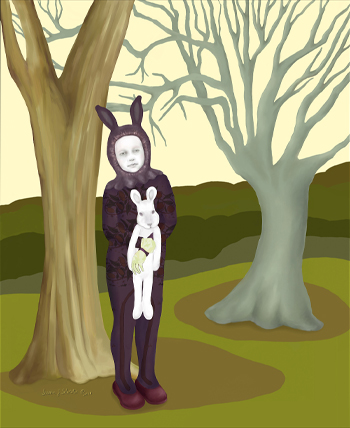
“Basically I got slammed in my review at school, and I got sad so I decided I’m going to draw people how I want to, and so I did,” she says. “I like people as animals. But it’s faux fur, it’s not real. I’m a vegetarian.”
The campus trees, squirrels and overall environment worked as a muse, as did Silvester’s more than 30 years of experience that ranged from Web design to art fabrication and replication animation.
Some of the particulars of these jobs are incredible. Silvester has built massive fiberglass sculptures for the Macy’s Thanksgiving Day Parade, created objects like children’s toys for comic strip Family Circle and designed the Rock and Roll Hall of Fame website.
Her artistic ability and dark humor came in handy when she worked on Pee-wee’s Playhouse and the Back to the Future ride at Universal Studios. Perhaps more impressive, however, was her work as an art fabricator in New York—her home state—for leading pop artists Robert Rauschenberg, Tom Wesselmann, Marisol and Lynda Benglis.
“As an artist, especially in New York, you just survive,” she says of the experience. “That was all sort of dark and wacky, so my work is still playful and dark.”
While working on the Back to the Future ride, Silvester decided to go back to computers and stop making large models as she had been for sets and other artists.
“I probably created enough toxic waste to last 100 million years,” she says. “I made a set that was 30-by-70 feet out of that foam that never breaks down and it was huge and disgusting. There were these huge bugs that came out of it. It was horrible. I said that’s it, I’m done with this, and then transitioned into computers. It was a good call.”
Silvester feels her digital work is almost more difficult than painting because she sees every flaw magnified.
“It’s really labor intensive and a lot of people don’t understand but this is all hand drawn,” she says of her digital work. Sometimes I’ll scan in my drawing but then I still have to paint it. I touch every part of that freaking piece. And when you flatten things (in Photoshop) then you have to fix it. I’ll still print something out and will see something and no one else will but I know it’s there. When I started painting, I kind of missed the ‘undo.’”
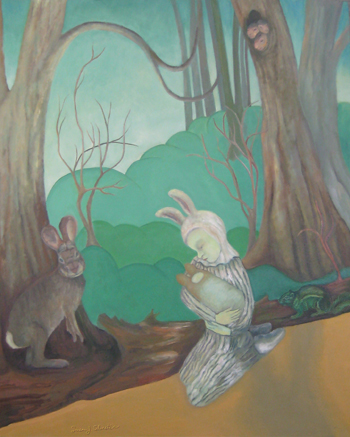
Silvester paints using mixed media, acrylics and oil. She has also recently incorporated her sculpting skills into her solo genre, sculpting bunny girls using clay and covering them with felt. If she completes the pieces, she may also include them in her show.
“I’m trying to show where I started and where I’m going so it’ll be interesting and help round out the show,” she says.
When she’s not in her studio or feverishly fixing every line and dot on her digital drawings, Silvester is teaching at the Art Institute, a job that has helped her go beyond “just surviving” as she did years ago in New York.
“Now I can do my art because I have that [the teaching],” she says. Silvester teaches color theory, drawing and design at the institute and also instructs senior classes at the Natomas Art Center in Folsom.
The art scene in Sacramento is also more her pace, Silvester says, after honing her career in both New York and Dallas.
“Since I moved here in 2001, the art scene has changed so much,” she says. “It’s expanded but it’s still a core group. I like knowing the different artists and seeing what they’re doing.”
She adds that attending school in Sacramento and having a studio at Verge has also positively affected her work and given her the confidence and feedback she needs.
“It has been a good place for me and we just kind of share ideas and critiques, so it’s really great for artists.”
Check out Gallery 2110 this July to see more of Silvester’s creations. A reception will be held July 13, 2013 from 6 to 9 p.m. Visit Susansilvester.com to follow her work.
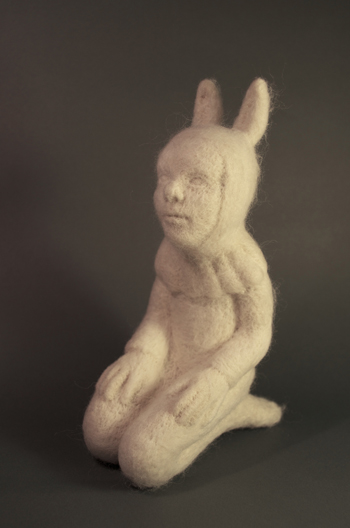
Folksy and poetic in the studio, Chicago’s Angel Olsen turns up the volume on her current tour
Angel Olsen’s name isn’t enormously familiar—yet—but once you hear her voice, you’ll recognize her immediately the next time around.
Olsen is on tour promoting her sophomore album Half Way Home, released by Bathetic Records and will be in Sacramento April 24, 2013 at Bows and Arrows. This is her first West Coast tour for a solo project.
The 25-year-old St. Louis native, now a Chicago resident, has been so successful that Bathetic insisted Olsen find a bigger label. They couldn’t produce copies fast enough.
Earlier this month, she signed with indie rock label Jagjaguwar, whose roster includes Bon Iver.
Olsen’s sound is distinct and raw, even more so on her first Garageband album Strange Cacti that she recorded lo-fi in her echo chamber of a kitchen. She describes her music style and dreams as “nostalgic.”
“It has a lot to do with what you’re comfortable with,” she says of why she chose this particular style. “Some people are comfortable in a certain zone. It makes sense to me in my mind. That’s real music.”
She indeed sounds like she’s from another time, invoking comparisons to icons from Joni Mitchell to Patsy Cline.
More contemporary comparisons could be made because of her folksy poet approach on some tracks—she would have fit well on the Juno soundtrack with “You Know Song”—or because of her Spanish and Middle Eastern influences, like on the track “The Sky Opened Up.”
She can quiver, yodel and deepen her voice in ways that lend her lyrics another dimension.
Her words are haunting even before the manipulation: “Deep in the nest of an endless dream, when a stranger thought becomes of me, it can slowly turn my blood,” she sings on “Safe in the Womb.”
Strangely enough, Olsen doesn’t give away any deep, dark secrets of her past in her music or in chatter. For now, she is a self-taught, down-to-earth young woman looking to make good music, and has already gained some life-changing experiences along her journey.
Look up Olsen on YouTube, and you’ll find her alongside indie artists Will Oldham, also known as Bonnie “Prince” Billy, and Emmett Kelly of the Cairo Gang. Kelly produced Half Way Home and plays keyboard and drums on the album next to Olsen’s guitar strumming.
“We tried to keep it as simple as possible and not sound overproduced,” she says of Half Way Home.
You might also find video of her in camouflage pajamas as a shrieking reincarnate of German singer Dagmar Kraus, part of an Oldham side project called The Babblers.
The experience benefited her music and musician connections, more so perhaps than when she first entered the scene as a teenager.
“For a hot minute, yeah, I was in a ska punk band and into reggae, in the late ‘90s early ’00s,” she says. “It was a weird moment in my life. We had a good time, but at that point I was just singing in the band and writing lyrics. I still listen to reggae.”
Olsen has yet to achieve her dream of a future steeped in nostalgia. She wants to be part of an old school rock ‘n’ roll band, the kind where everyone is a part of the process—everyone sings and writes honestly and is critical of each other, she says.
“I’ve thought about it a lot, and it’s a dream. And once it occurs I’m sure there are weird dynamics and other stuff that would have to be worked out,” she says. “Now, people have to be everything on their own—they have to be sexy and dance—but all you really need is to just be able to play music well.”
This earnestness has paid off in the form of fans and raving reviews, and Olsen is a little closer to her dream with her current setup. Though she performs solo for parts of her shows, she also brings a full band: cellist Danah Olivetree, drummer Joshua Jaeger and bassist Stewart Bronaugh.
“We don’t play the same way the album was recorded,” Olsen says about the tour, which started at the beginning of April. “We practiced together for only four days and now we’re on our fifth show and it’s going great. I get to change the songs a little bit, and they’re adding different things.”
Olsen says to expect a louder band than what might be expected if you’ve heard her recorded music.
“It’s been really fun to work with a group of people who have been patient with me and let me direct them,” she adds. “I’m learning a lot.”
Catch her if you can at Bows and Arrows, 1815 19th Street, before she heads overseas to the Land of Guinness.
Angel Olsen will play Bows and Arrows in Sacramento on April 24, 2013. It is her last U.S. date before heading overseas, so be sure to give her a proper send off. Villages and Olla will also perform. Tickets are $10 at the door and $8 in advance, which can be purchased through Bowscollective.com. Learn more about Olsen at Angelolsen.com.
Speaking in front of people scares Corey Bernhardt. So does tattooing, painting and producing comic books. But he does all four.
“I like to challenge myself,” the Sacramento native says. “Tattooing scares the shit out of me, but that’s why I do it. That’s why I paint. I make this statement, ‘I’m gonna do this’ and it scares me to talk in front people but that’s why I love it.”
He admits to being scared of this interview too, but along with his ability to face his fears, Bernhardt knows he wants to connect with people and to learn from experiences and mistakes.
He also knows that all he’s ever wanted to be since he learned to read is a comic book illustrator.
“I had a friend who lived down the street when I was 5 or 6 years old and he had three or four comic books, and I was instantly blown away,” says Bernhardt, now 32. “He gave them to me probably because all I wanted to do was look at them when I went to his house, and I just read them front to back over and over again and started trying to emulate the illustrations.”
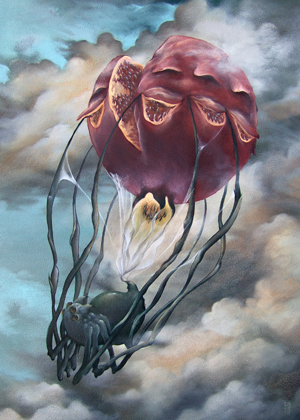
Bernhardt didn’t release his first creator-owned comic book Cardboard City, until 2010, some 15 years after his childhood comic experience. The short-lived action sci-fi publication with a robot as a main character received mixed reviews.
“I made a lot of mistakes,” he says. “I had never done a comic book before. I had trouble drawing certain things, or the pacing wasn’t right. I want to take what’s there and rework it and re-release it.”
Bernhardt loves storytelling and when he’s not painting, teaching or tattooing, he is home storyboarding and figuring out characters.
He started his professional art training in his early 20s, when a friend got him an interview for a graphic design position at a Tower Records production office.
“I started at Tower Records—it was kind of like the evil empire, a bizarre work environment,” he says looking back. “When I started I had no real graphic design experience, I knew a little Photoshop, I was 20 or 21, but I took some of my work and titled the folder ‘Please hire me,’ and the person interviewing said ‘It’s not the best work, but I like your attitude.’”

Bernhardt learned from other graphic artists working at the office and later produced freelance work for local bands and businesses—flyers, stickers, whatever he could try.
Hoping to further hone his skills, Bernhardt studied illustration in 2005 at the Academy of Art in San Francisco. In 2009 his freelancing and illustration work landed him an apprenticeship at Pretty in Ink Tattoo in Roseville.
“I never in a million years thought I would be a tattoo artist,” Bernhardt says. “When I was 19 or 20, I had some friends say I should tattoo but I was intimidated by tattoo artists. I didn’t have that persona, didn’t think I could hang out with them. But through graphic design, I got into it.”
Along the way, Bernhardt found much respect for tattoo art and painting.
“What I like about tattooing is it allows me to crisscross back and forth between the art forms, switch gears and do more sequential work or illustration, then go to painting,” he says. “I can’t say I love one over the other. And I think that’s how art is going today. You have to be able to cross genres, put down the pencil and pick up a camera, then put down the camera and pick up a paintbrush. But it is hard to find a distinct style.”
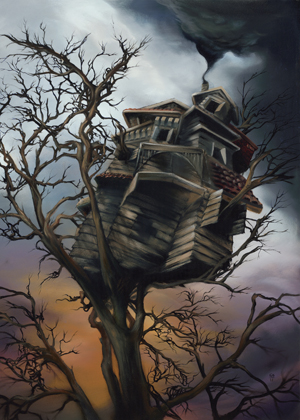
Bernhardt says he found his painting style, which reflects in his other work, when he first started putting oil on wood.
“I was never interested in painting—I just wanted to be a comic book illustrator—but when I started working at a tattoo shop, both tattoo artists I worked with were oil painting and they would bring out a canvas in between clients,” he says.
The practice intrigued him.
“With tattoos you would think it’s more about drawing, but it’s more like the fundamentals of painting, color theory, mixing colors,” he says. “Until I tried it I didn’t realize that. And when you work at a shop, you can put [your painting] behind you and a client will see it and might want it. It’s one more thing in your arsenal when you’re a freelance artist or independent contractor.”
So Bernhardt took a magnifying glass to his favorite artists’ prints and chose oil on wood to begin painting. A Circa Survive album cover inspired him, and he found out the artist had been Esao Andrews. His style, along with that of James Gleeson, left an impression.
“When I saw what those guys are doing I was like, yeah, that’s what I want to do,” he says enthusiastically. “It’s beautiful, grotesque, what I admire and I’m trying to emulate that kind of universe that they paint in. I think what made me so attached to that style of painting is when you see the painting, you want to be there, you want to see what it’s like to live there for a day.”
Bernhardt is more attracted to painting the bizarre in nature, using animals, insects and fruit.
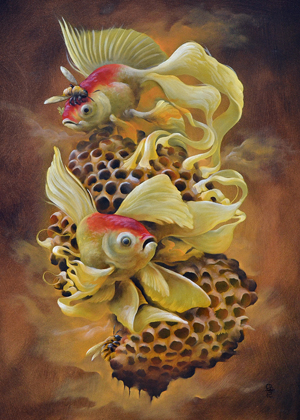
“I like to do bizarre things like put a fish in the sky, a bird under water,” he says. “It’s more a conceptual thing than a message. I’m not trying to convey a message, I’m just trying to get a feeling out of it.”
Bernhardt has only been practicing fine art for a couple years, but he has befriended a slew of Sacramento artists along the way. After connecting with local tattoo artist Jessica Ann White, and sharing with her a vision for a fine art gallery that also includes a tattoo shop, the two decided to open Reclamare Gallery and Custom Tattoo at 2737 Riverside Boulevard in Land Park.
The gallery will host pieces from both Bernhardt and White regularly, as well as from Andy Steele, Jared Tharp, Chris Bales, Jared Konopitski, Jacquelyn Bond, Jayme Goodwin, Andrew Luck, Jason Taylor, Kathryn Mayo and Joel Smith during April’s Second Saturday.
“I wanted to get people to keep coming to the shop and also help other local artists by being a hub,” Bernhardt says. “You see that nowadays, there will be a gallery but there will be a bar or something in it, so the gallery doesn’t draw a lot people but you can get them in for a drink. I wanted people to know this was for fine art. It’s a gallery for artists who happen to do tattoos.”

He also wanted a place to host local workshops, classes and artists who could teach painting, as a way to give back to the community that supported him. Currently, Bernhardt teaches figure drawing at University Art on Marconi Avenue.
“I just want for people to be comfortable and talk about art and not be intimidated by that whole culture,” he says of the new gallery.
Bernhardt is happy with the location of the gallery and shop because he doesn’t want to take away from the tattoo studios that have been established downtown, and because the gallery is in line with a few others in the immediate area.
“We’re also across the street from the cemetery, which is kind of creepy but it’s beautiful,” he says, noting he thought the shop might be haunted but took care of any possible spirits before opening.
Just another small scare along his path. No big deal.
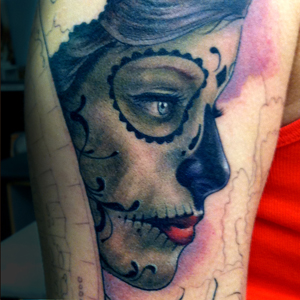
For more info, visit Reclamare’s little corner of Facebook, Facebook.com/Reclamaretattoo.
Pizza Rock’s owner Tony Gemignani played his part in the revitalization of K Street and now looks to bring his recipe for success to Sin City
When Pizza Rock opened in 2011, its owners joined area entrepreneurs in helping transform K Street from a dim portion of downtown to a pedestrian-friendly neighborhood in the midst of revitalization.
The city has a ways to go, but Pizza Rock owner Tony Gemignani says he and co-owners George Karpaty and Trevor Hewitt have had success, choosing K Street because of its great potential and the steady business of the co-owners’ clubs—Dive Bar and District 30—in the area.
“It was a concept we had talked about for many years,” Gemignani says of Pizza Rock’s nightclub vibe—from the rock music rendition of Michelangelo’s Adam painted on the ceiling to the savvy music system allowing for sound to be simultaneously transmitted between Pizza Rock, Dive Bar and District 30.
Gemignani credits the restaurant’s success to his hardworking management and staff, top quality ingredients, diverse menu and unique atmosphere.
“We are always updating and changing so it’s a diverse menu,” he says. “We keep our core pizzas and [appetizers] and everything but we tend to change parts of the menu to suit the customers. Sacramento likes substance, Sacramento likes value and when you look at our bigger pizzas, the Sicilian and the Romana, you get more for your money, so those have really taken off.”
Ironically, one of the biggest sellers is also Gemignani’s burger, ordered anywhere from 80 to 100 times each day, he says. It’s something he’s looking to branch out with down the road.
In the meantime, Gemignani and partners have decided to open a second Pizza Rock in the ideal place for the concept—Las Vegas.
“For the new Pizza Rock in Vegas, we got together to plan everything, and that’s part of us,” Gemignani says about the team’s enthusiasm to design the entire place from the bottom up. “[In Sacramento] we were a big part of every decision, from the carpet, menu, vibe, all the way down to the people we interview. It’s an experience, a package and that’s what we look at, from how the restaurant should look to how the servers should act. They’re a little edgy, but that’s what’s cool.”
When it comes down to it, however, Pizza Rock has repeat customers not just because of the vibe, but because of the food, which is made with fresh local ingredients as well as specially imported items from Italy.
An award-winning pizza maker and instructor who owns three restaurants in San Francisco and has four other projects in the works, Gemignani had 20 years of experience to bring to the Sacramento table when restaurant talks first began.
In 2007, Gemignani took first place at the World Pizza Cup in Naples, Italy, in the Neapolitan category with his Pizza Margherita, becoming the first American in history to win the honor. Today, Pizza Rock and Tony’s Pizza Napoletana in San Francisco recreate that award-winning pizza using the exact ingredients and oven.
He won first place at the 2011 World Championship of Pizza Makers, has won several Food Network challenges and landed in the Guinness Book of World Records for spinning the largest pizza dough base (33.2 inches) in two minutes. Gemignani also owns and operates the International School of Pizza in San Francisco, teaching several styles, certifying professionals and instructing non-professionals for home cooking.
At his restaurants, you will not only find his classic Italian pies and dishes, but also authentic Chicago, New York, St. Louis, Detroit and other styles of pizza.
“When I won a bunch of awards, I traveled worldwide and nationwide, and during those stops, I ended up working with a lot of great independent operators who had different ingredients and different customers,” Gemignani says. “When you looked at those styles [in other places], people had not been doing them correctly or not at all. I wanted a restaurant with multiple ovens, multiple flours, multiple tomatoes to make each one authentic. I’ve been lucky enough to work with great people and go back to my restaurants and bring those styles.”
Asked which style is his favorite, Gemignani laughs and says he likes them all, if they’re done right.
“It’s like saying which pasta you like best, like you like spaghetti but hate linguini, but you can’t say you like one and hate the other because it’s still pasta,” he says. “If the pizza is light, not too weighed down, the dough is matured properly and you use fresh ingredients, I like it. But you can really screw that up.”
Freshness, Gemignani learned at a young age, is key. Growing up on a farm in Castro Valley, Calif., Gemignani watched his mom cook every day with the ingredients they grew. Coincidentally, he also gets his design interests from his mom, whom he watched decorate an inviting home for his family for years.
At 18, Gemignani started working at his brother Frank’s Pyzano’s Pizzeria in Castro Valley (which closed its doors just last year after 21 years). He later attended Scuola Italiana Pizzaioli to become a certified pizza master and has worked nonstop since.
For those who can’t visit his restaurants or attend his school, Gemignani has written two cookbooks and is working on a third, which is, of course, pizza-related.
But for the man who eats, breathes and dreams pizza, he still has a lot of new ideas up his sleeves, and will continue to roll them out at Pizza Rock in the near future.
Painter Mark David Manning tears into collage
For those who know Mark David Manning’s art, next month’s exhibit at Gallery 2110 is atypical.
Manning is a traditionally trained oil painter who uses both real life and imagery to portray a balance between man, nature and machine. His interests are environmental and political, stemming from his upbringing in New Zealand and his personal beliefs.
In one of his older collections of household imagery, a still life of a vacuum is no longer just an everyday contraption when it comes dangerously close to sucking up fowl eggs.
In another previous work, Manning has painted a beautiful woman who suddenly seems wild and distorted as her innards fall out of her and whales swim nearby against rich reds on the canvas. This oil painting, Anti-whaling, is one of Manning’s favorites, encompassing his environmentalism.
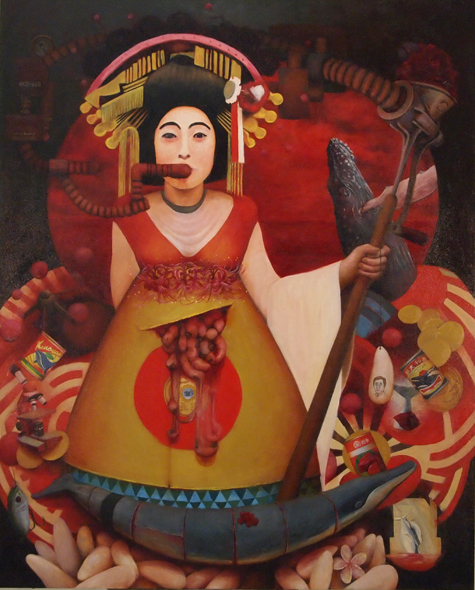
His latest body of work, Visual Odyssey, will delight and stretch the viewer’s mind in a slightly different way than Manning’s oil paintings have done with their strong messages.
Visual Odyssey is an interpretive study with more than 30 mixed media collages that are made from 99 percent recycled materials. Manning collected old photography, books and other odds and ends around his Midtown home and incorporated some oil into the final pieces.
“This is not something that I usually do. It’s not common for me,” Manning says. “This is a new direction I’m going for.”
The collages are all original and very different from one another, each telling their own stories, Manning says, but his inspiration came from Stanley Kubrick’s 1968 sci-fi epic 2001: A Space Odyssey.
“[The collection] is about a transition from early man, from the earliest beginnings, to how much we have advanced, from hand tools to flying,” he says.
His favorite piece of the collection is one of the five larger collages, called Flight, and uses a ‘50s-style palate of blues, oranges and teals with unique shapes.
Manning says the immediacy of collage is what appealed to him, as well as the ability to use color and shape as he has done with oil for years.Â
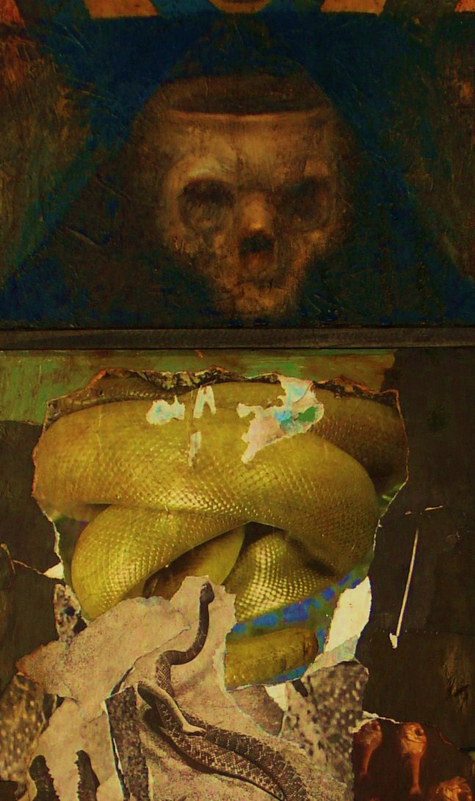
“Oil paintings, they’re very slow to build because it takes some time to get the right color,” he says. “Collage is more immediate than oil… You can flip through a book and find what you want. It’s more like painting a landscape, because you’re painting a lot faster. I like the immediacy of laying down the paper and tearing down the paper. It’s more raw than oil.”
Despite this newfound love, Manning says he will continue with oil painting and is already arms deep in his next body of work–a series based on Willy Wonka and Chocolate Factory.
“I’m pretty focused, and I’ll keep on doing what I’m doing and exploring different ideas,” Manning says. “I’ve always liked the medium [oil] itself. Color is incredibly important to me, and oil intensifies the pigment.”
These intensities work well with his subject matter, whether he’s depicting animals in nature or something more abstract like in his last show The Supernatural, with juxtapositions of unrelated manmade and natural objects unconventionally placed for still life.
Manning sees his subconscious when creating art.
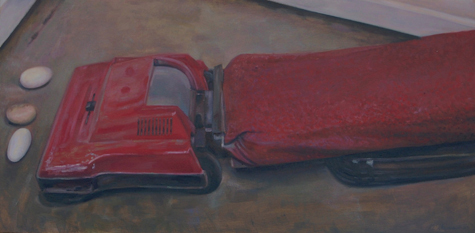
“I’m definitely an environmentalist, so the environment comes out in my work,” he says. “If something is bothering me in reference to something going on environmentally, or with respect of nature, or respect of animals, or man’s relationship to nature, it just comes out.”
His contemporary, sometimes crazy thoughts portrayed through his traditional painting style have been warmly received and supported in Sacramento thus far, Manning says. He only hopes gallery visitors will enjoy each piece of his newest exhibit and create their own stories from the images.
To see more from Manning, visit Visual Odyssey Dec. 1—29, 2012 at Gallery 2110, part of the Sacramento Art Complex at 2110 K Street.
